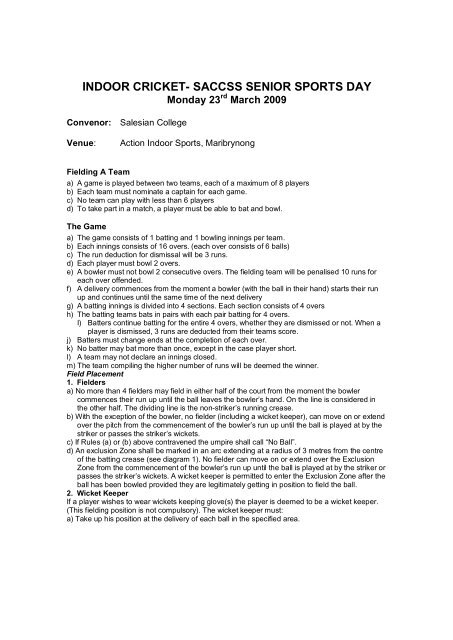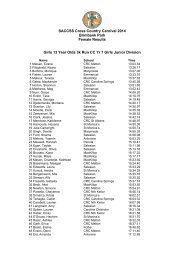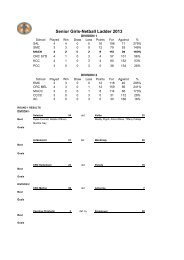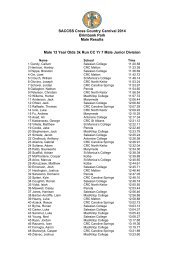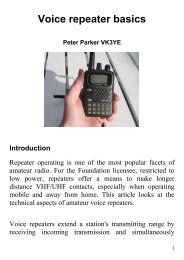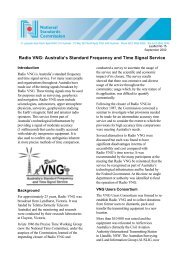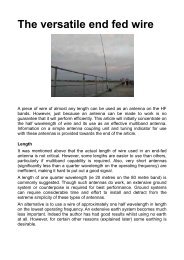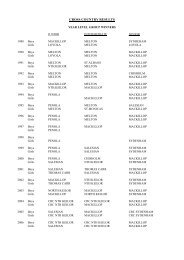Create successful ePaper yourself
Turn your PDF publications into a flip-book with our unique Google optimized e-Paper software.
INDOOR CRICKET- SACCSS SENIOR SPORTS DAYMonday 23 rd March 2009Convenor: Salesian CollegeVenue:Action <strong>Indoor</strong> Sports, MaribrynongFielding A Teama) A game is played between two teams, each of a maximum of 8 playersb) Each team must nominate a captain for each game.c) No team can play with less than 6 playersd) To take part in a match, a player must be able to bat and bowl.The Gamea) The game consists of 1 batting and 1 bowling innings per team.b) Each innings consists of 16 overs. (each over consists of 6 balls)c) The run deduction for dismissal will be 3 runs.d) Each player must bowl 2 overs.e) A bowler must not bowl 2 consecutive overs. The fielding team will be penalised 10 runs foreach over offended.f) A delivery commences from the moment a bowler (with the ball in their hand) starts their runup and continues until the same time of the next deliveryg) A batting innings is divided into 4 sections. Each section consists of 4 oversh) The batting teams bats in pairs with each pair batting for 4 overs.I) Batters continue batting for the entire 4 overs, whether they are dismissed or not. When aplayer is dismissed, 3 runs are deducted from their teams score.j) Batters must change ends at the completion of each over.k) No batter may bat more than once, except in the case player short.l) A team may not declare an innings closed.m) The team compiling the higher number of runs will be deemed the winner.Field Placement1. Fieldersa) No more than 4 fielders may field in either half of the court from the moment the bowlercommences their run up until the ball leaves the bowler’s hand. On the line is considered inthe other half. The dividing line is the non-striker’s running crease.b) With the exception of the bowler, no fielder (including a wicket keeper), can move on or extendover the pitch from the commencement of the bowler’s run up until the ball is played at by thestriker or passes the striker’s wickets.c) If Rules (a) or (b) above contravened the umpire shall call “No Ball”.d) An exclusion Zone shall be marked in an arc extending at a radius of 3 metres from the centreof the batting crease (see diagram 1). No fielder can move on or extend over the ExclusionZone from the commencement of the bowler’s run up until the ball is played at by the striker orpasses the striker’s wickets. A wicket keeper is permitted to enter the Exclusion Zone after theball has been bowled provided they are legitimately getting in position to field the ball.2. Wicket KeeperIf a player wishes to wear wickets keeping glove(s) the player is deemed to be a wicket keeper.(This fielding position is not compulsory). The wicket keeper must:a) Take up his position at the delivery of each ball in the specified area.
the top net into a scoring zone net results in a normal score being achieved as if the ball washit directly from the bat or hands holding the bat. Dividing tapes or supports will be deemed tobe part of the higher bonus-scoring zone.c) When and if the two batters cross between the batting crease and the running crease afterhitting the ball or at any other time the ball is in play, one run is scored. This score is anaddition to the bonus score achieved by striking the scoring zone net.d) The area behind the batting crease has no score value but runs may be taken when the ball isplayed into this area by crossing between the batting crease and the running crease.e) Should a member of the bowling side misfield or deflect the ball into a scoring zone net afterthe ball has been hit by the batter, appropriate runs will count. If in the Umpires opinion, thefielder has deliberately and intentionally tried to deflect the ball onto wickets to achieve a runout, no bonus runs will be scored if the ball subsequently hits the net.f) Any ball deflected from the batter’s body into a scoring net shall not be counted, however, thebatter may take a run by crossing.g) Should the ball be hit into a runner then rebound into a scoring zone net bonus runs will apply.No Ball1. “No Ball” will be called when:a) The ball is thrown, not bowled. If the umpire is not totally satisfied with the fairness of thedelivery, “No ball” will be called at the moment of delivery. (Note: As a guide, the bowler’s armmust not be straightened in the delivery action. If the elbow remains bent throughout thedelivery, it may be a fair delivery).b) Any part of the bowler’s front foot is not grounded inside the return crease and behind thepopping crease at the moment of delivery. (Note: Any part of the front foot on the line is a “NoBall”).c) If any part of the ball, when bowled underarm, pitches on or before the underarm line it will bea “No Ball”.d) There are more than 4 fielders in either half of the court at the commencement of the bowler’srun up.2. A batter can be given “Out” off a “No Ball” in any of the four following ways:a) If the ball is hit twice other than to protect the wickets.b) If either batter deliberately interferes with the fielding team.c) If in attempting a run, either batter is run out.d) If the striker is run out by the wicket keeper.3. Any batter dismissed off a “No Ball” will be penalised 3 runs. The 2 run bonus for the “No Ball”is negated by the dismissal.a) A “No Ball” is included as part of an over except in the last over of the innings.b) Any “No Ball” bowled in the last over of an innings may be re-bowled at the batter’sdiscretion. The umpire must ask the batters immediately if the ball is to be re-bowled. Thebatters must decide before the next ball is bowled. Any penalties, runs or wickets resultingfrom the “No Ball” delivery will count regardless of whether the ball is re-bowled or not.c) A “No Ball” incurs a penalty of 2 runs, which is added to the batting pair’s score. Runsscored by hitting any net zone and/or physical runs are also added to the score.Dismissals.The striking batter will retain the strike, after being dismissed, unless the batters have crossedprior to the dismissal. A batter who is dismissed “bowled” or “leg before wicket” will retain thestrike irrespective of the batters crossing.A batter can be given “Out” for any of the following dismissals:1. BOWLED: If the ball strikes the wickets, including coming from the batter’s person orequipment and at least one of the bails is completely and permanently removed. Note: The baseplate of the stumps is considered to be part of the wickets.
2. CAUGHT: If a ball, coming from the striker’s bat or their hand(s) holding the bat, is caughtbefore it touches the ground. The striker will be out “caught” should the ball pass from the batonto the striker’s body, or vice versa, before being caught.a) A catch may be taken off all boundary netting except a direct hit on the full to the net (ZoneD). A ball passing from a fielder’s hand or body directly onto the 6 net, on the full and thencaught, will result in the striker being not out and the bonus runs will count. The striker willbe out “caught” if a ball is hit into the side netting (Zones B or C) before passing onto theback net (Zone D) and is caught without touching the ground.b) Should a ball hit the non-striker and then be caught before touching the ground, the strikerwill be out.c) The striker will be given out if the ball is caught after it has come from their bat or thehand(s) holding the bat and then deflected onto their protective equipment.d) A batter will not be out “caught” if the ball came from the bottom wire supporting the net.3. STUMPED & RUN OUT: The difference between “run out” and “stumped” is that in the formera batter is attempting to make a run, whilst in the latter, the batter is stranded out of theircrease after playing a shot and is attempting to regain their batting crease.a) Stumped. A batter is stumped when the wicket keeper legally removes the bail(s) before thestriker (who has advanced down the pitch) is able to get any part of their bat or bodygrounded inside their crease. The wicket keeper may use the hand(s), or the forearm of thehand(s), holding the ball or as a result of the ball rebounding directly from the keeper’sbody onto the a stumps.b) Run out:1. A batter is run out when either batter has left their crease, while the ball is “live” and thebails are dislodged by the ball held by or coming directly from a fielder, before any part ofthe batter’s person or equipment is grounded behind the line of the appropriate crease.Once a batter is safely behind the line of the crease they cannot be given out.4. L.B.W.: If the ball his the striker’s body and the striker has made no attempt to hit the ball,the batter will be adjudged LBW if, in the opinion of the umpire, the ball would have struck thestumps.5. HIT WICKET: The striker will be out “Hit Wicket” if their person or equipment breaks thestumps whilst either playing the ball or immediately setting off for the first run after playing atthe ball. The base plate of the stumps is considered to be part of the stumps. A batter is notout should they break the stumps trying to regain their crease or complete a run.6. MANKAD: If the non-striker leaves the crease prior to the delivery of the ball and the bowlercompletes a delivery action then breaks the stumps with the hand holding the ball, the nonstrikerwill be out “Mankad”. A mankad attempt does not have to be in one continuos motionbut the ball must remain in the bowler’s delivery hand throughout the mankad attempt.7. INTERFERENCE: A batter can be given out for interference:a) If either batter deliberately interferes with the ball whilst it is in play.b) If either batter deliberately obstructs or interferes with any member of the fielding team,bearing in mind that the fielder has the right of way provided they are legitimately fieldingthe ball. Note: Even if they are running in a “straight line” between the batting creases, it isthe batter’s responsibility to avoid the fielders.Note: Should any player deliberately endanger an opponent, irrespective of the right of wayprovisions, they will be dealt with under the Misconduct Rule.** These are abbreviated rules. For the full version, contact the Executive Officer.


